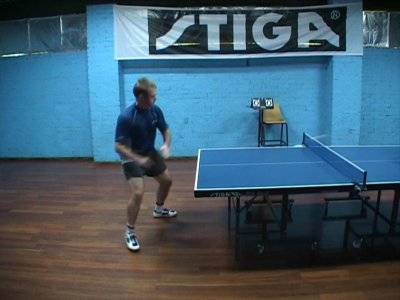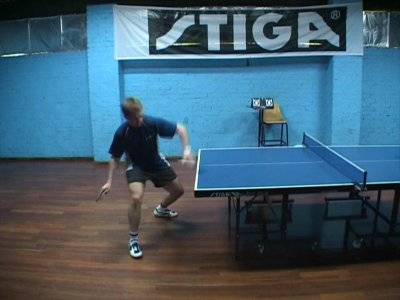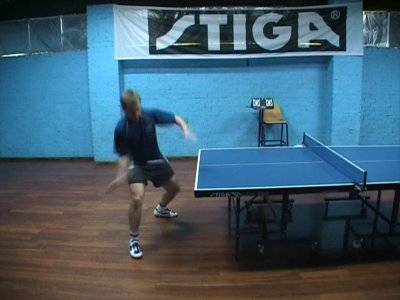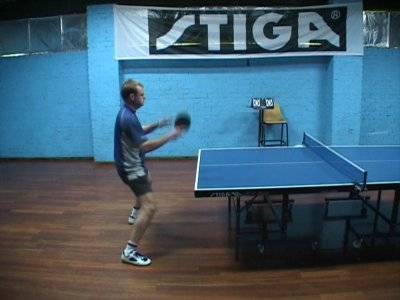I would recommend making the forehand loop against backspin the first of the advanced strokes that you learn for a couple of reasons.
- In more advanced play, the first attacking stroke is usually a loop against a pushed ball.
- The backspin from the push will force you to perform the stroke with good form, or you are unlikely to successfully hit the ball on the table.
The idea behind this stroke is to hit the ball around six inches over the net with medium-fast to fast speed and heavy topspin to help bring the ball down on the other side of the table.
Ready Position

© Greg Letts
Points to look for:
- The feet are placed with the right foot slightly further back than the left foot, to make it easier to put weight on the right leg during the stroke.
- Most of the weight is on the balls of the feet to allow quicker movement. Too much weight on the heels will slow down movement, and too much weight on the toes will affect balance.
- The weight is evenly distributed between the left and right legs.
- The knees are bent and the feet are around one and a half times shoulder width apart. The torso is also leaning slightly forward. This gives a lower centre of gravity for better balance, and allows for easy movement in all directions.
- Shoulders are in line with the legs, with the right shoulder slightly behind the left.
- The arms are held roughly shoulder width apart, with around a 90 degree angle at the elbow. The bat should be above the table to allow easy stroking of short balls.
Middle Of Backswing

© Greg Letts
The pushed ball is coming to the forehand side and the decision has been made to play a forehand loop. The backswing begins the stroke.
Points to look for:
- The right foot and leg have turned to the right, in preparation for having more bodyweight placed upon them.
- The hips, waist and shoulders have also turned to the right, although the head is still facing forward watching the ball.
- The bat has only moved slightly backwards and downwards at this point. The amount that the bat moves backwards will vary from player to player, and will also be affected by the amount of power the stroke is hit with.
- Note how the free arm has turned in synch with the playing arm, which helps maintain balance.
End Of Backswing

© Greg Letts
The ball has just bounced on the table, and the backswing has finished.
Points to look for:
- Much of the bodyweight has been transferred onto the right leg. This will allow the player to turn his hips, waist and shoulders to the right and then back to the left without losing balance.
- The free arm has moved forward to help maintain balance, since the playing arm has continued to move backwards and downwards.
- The left and right arms are now parallel to the endline of the table. Notice that the shoulders have turned more than the hips and waist.
- The right shoulder has dipped slightly more than the left shoulder, so that the left hand is higher than the right hand. The right hand is a little above and directly behind the right knee.
- The head has turned to allow the player to keep watching the ball comfortably and closely.
- Both knees have bent, to allow the player to get lower relative to the ball, since the direction of the forward stroke will be forwards and upwards.
- Although it cannot be seen from this photo sequence, the player has paused his bat at the end of the backswing for a fraction of second before swinging forward.
Contact With The Ball

© Greg Letts
The player has begun his forward swing and is about to make contact with the ball.
Points to look for:
- The head has continued to turn to watch the ball closely.
- The angle of the bat is at a roughly 45 degree angle, with the tip of the bat pointing towards the camera.
- The hips, waist and shoulders have just begun to turn forwards again.
- The knees and torso are beginning to straighten, which adds to the amount of lift given to the ball.
- The forearm and bat are moving faster than the shoulders, as shown by the slight blurring in the photograph.
- If the ball was compared to a clockface, the bat has made contact at a point roughly around the number 10, while the bat was moving equally forwards and upwards. Note that the angle of the bat remains at around 45 degrees.
- The ball is hit with a roughly equal mixture of solid and brushing contact, with the bat moving in almost a straight line when viewed from the side. Because of the existing backspin on the ball, this movement will make the ball go mainly forwards and a little upwards, with heavy topspin.
- The free arm has also started to lift, to help maintain balance.
Middle Of Follow Through

© Greg Letts
The ball has been struck, and the player is in the middle of his follow through.
Points to look for:
- The knees and torso have continued to push upwards, as part of the upward motion of the swing.
- The playing arm has bent at the elbow, so that the tip of the racket is now pointing upwards. This is the motion called the ‘salute’.
- The hips, waist and shoulders have continued to turn back towards the left.
- The free arm has continued to move upwards to help maintain balance.
End Of Follow Through

© Greg Letts
The forward swing has come to an end, and the ball is on its way.
Points to look for:
- The player is now watching his opponent at the other end of the court, rather than the flight of the ball.
- The hips, waist and shoulders have completed turning back to the left.
- The hips, waist and shoulders are a little higher than the original ready position.
- The racket has moved a little more forward and further upwards. The tip of the racket is now pointing upwards, in what is called ‘the salute’.
- The elbow of the playing arm is a little below shoulder level, and the bat has not crossed past the middle of the body. This helps to maintain balance and improve recovery time.
- The free arm has continued to aid balance by moving in synch with the playing arm.
- The player is currently airbourne, due to the amount of upward force generated during the swing. Some players tend to do this more than others.
Middle Of Recovery To Ready Position

© Greg Letts
The player is in the middle of his return to a basic ready position.
Points to look for:
- The player is back on the ground, but his feet have turned further to the left than they were in his original starting position. This is due to the force of the swing.
- The player is dropping his hands, which is all he needs to do to allow them to get back to their ready position.
- The torso of the player has finished in an upright and balanced position, so that movement in either direction can be achieved easily. This is preferable to overswinging and finishing with a lean to the left, where you would then need to regain your balance before you can move to the next shot.
Recovery To Ready Position
 The player has almost returned to the ready position.
The player has almost returned to the ready position.
Points to look for:
- The arms have continued to drop towards their ready position. The bat is in a neutral position, from which it is equally easy to play a forehand or backhand stroke.
- The player is now watching the ball coming towards him.
- The knees are slightly bent again, allowing for better movement in all directions.
- The player will return to a slight forward lean, and move his feet back into his basic ready position shown in Step 1, as the ball continues to travel towards him.
- His bodyweight is again evenly distributed between his left and right legs, and he is on the balls of his feet.

